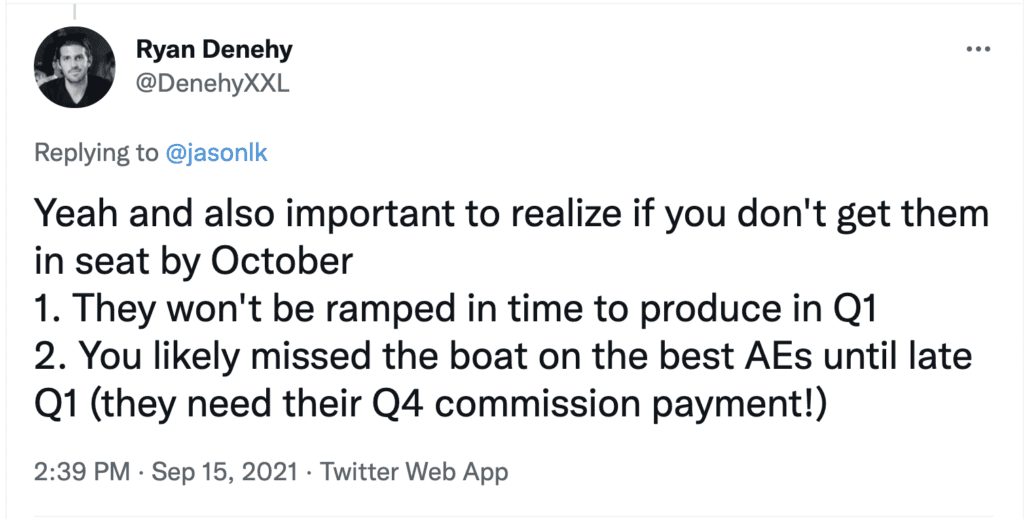If you want to hit the plan for Q1'22,
You need to be hiring all the sales reps you'll need then …
Now
— Jason ✨BeKind✨ Lemkin ⚫️ (@jasonlk) September 15, 2021
Recurring revenue certainly has pros and cons. The biggest pro is it recurs. 🙂 With even 120% NRR, you basically double in 4+ years even with no new customers. Now that’s magic.
But maybe even up to $20m ARR, the biggest downside of recurring revenue is that you only get to recognize 1/12th of your ACV (annual contract value) each month. That means if you don’t start off Q1 really strong, you’ll get in such a hole for Q2-Q4 that you’ll never hit your 12/31 plan for next year. Because if too many of those Q1 deals slip to Q2, even if they still close, you’ll only be able to recognize 8/12th or 7/12ths or it or so next year. You just can’t make it up.
You can try and hide this “issue” by talking about bookings instead of ARR. But that’s for suckers. Actual recurring and recognized revenue is, has, and always will be, what matters. That, and of course, someday, profits.
The Good News: It’s not Too Late for 2022 — but it’s close. To make the hires you need now, for next year. But you have to hire them NOW, not in January. Not after you get through the year. Not after you spend 100%+ of your time doing whatever it takes just to hit this year’s nearly impossible plan. 🙂
I’ll Keep it Simple. I just want you to find a way to do 5 things:
- First, it’s time to build a real financial and operating model for next year — NOW. With precise headcount and budget needs. Pick a real ARR target for the end of next year, and back into who you’ll need to hit it — month-by-month. How many reps. How many SDRs. How many MQLs, how big a marketing budget, and how many in marketing. How many Customer Success Managers.
- Second, you have to try to hire as many of the sales reps you’ll need for the end of Q1 … by early Q4 at the latest. This is key. Even in the best of cases, with the best onboarding and the shortest of sales cycles, it takes 30 days to scale a rep. Usually much more == 90 days or longer. Whatever it takes, if those reps you need to hit the Q1 and Q2 plan aren’t there and scaled on January 1 or earlier … you will never make the plan. When you think about this, you’ll usually see you’re already in the hole in terms of not having hired enough good sales reps for 2022.
- Third, build a real marketing / customer acquisition / demand gen budget for next year — and figure out how to start it in Q4 … and how to fund it. If you don’t get the leads you need in Q4 as well … you’ll miss Q1 and even Q2 badly as well. You can’t wait until Q1 to get the leads you’ll need for next year.
- Fourth, get the customer success team in place for Q1+ now as well. You are going to fall on your face if you can’t make your best customers, and really, almost all your customers, happy. Each year, referrals, word-of-mouth, and your mini-brand get more and more important. Second Order Revenue grows each year in significance. Don’t let yourself, and your sales team down, by not being able to make those precious deals that do close this year, a success in the next one.
- Finally, multiply the numbers of reps and leads/MQLs you’ve carefully calculated that you need … by 1.5x. Always. However many sales reps you think you need next year — you always need at least 1.5x more. You’ll be counting on too much sales efficiency, and too perfect and linear a hiring plan. You’ll need 1.5x the reps, and 1.5x the leads your carefully crafted plan says. Maybe even more during #thegreatresignation.
In fact, as you think about it, you’ll realize you’re in fact late.
If this year is going OK but you’re behind on next year’s hiring plan, it’s OK. What’s done is done, and you’ll pull through with the sales team you do have until the cavalry comes.
But you have to stop for a minute, take a pause, build the model … and find a way to hire even more, most likely.
Otherwise, it will just be too late.
(note: an updated SaaStr Classic post)



